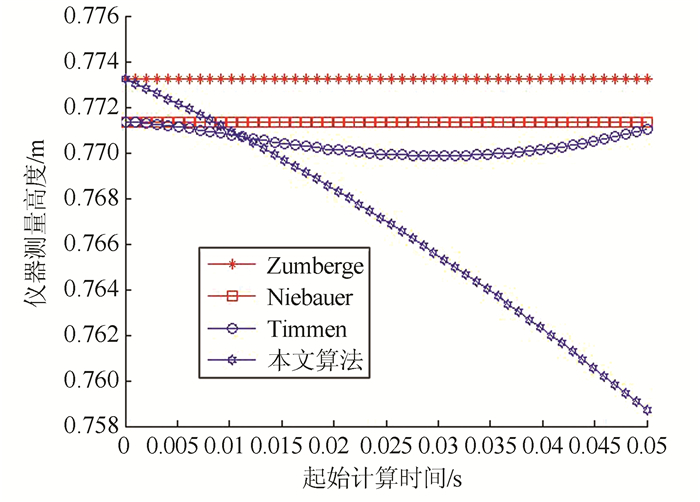-
摘要: 在激光干涉绝对重力仪的研制中,每次测量落体都要自由下落7~20 cm的距离,在此过程中地表重力垂直梯度引入的误差最高可达60×10-8 m/s2。因此,需要计算出每次测量值对应的测量高度,即在该位置时,落体运动的距离内重力垂直梯度对绝对重力测量值的综合误差为零。基于对落体下落运动方程的分析,提出一了种新的绝对重力仪测量高度的计算方法。对比发现,当起始计算时间较小并接近于0(小于0.015 s)时,该算法与已有的算法结果具有较好的一致性,最大偏差不大于3 mm,梯度归算误差不大于1×10-8 m/s2(μGal)。在仪器自主研发的过程中,当起始计算时间较长(大于0.015 s)时,该算法可以更合理地计算绝对重力测量值对应的测量高度。Abstract: In the design of laser interference absolute gravimeters, the falling-body for each measurement needs to freely fall about 7-20 cm along the vertical direction, corresponding to a gradient error up to 60 μGal. So the measurement-height must be computed where the combined effect of the gravity gradient is equal to zero. This paper bases on the analysis for the equation of the falling-body movement and proposes a new algorithm to calculate the measurement-height of the absolute gravimeter. From the comparison with other algorithms we could find:(1) if the beginning time of the trajectory is close to zero(less than 0.015 s), the measurement height of the absolute gravimeters using our algorithm coincides to the other algorithms, with the maximum deviation less than 3 mm and the gradient error less than 1 μGal; (2) during the process of independent research and development, if the beginning time of the trajectory is more than zero(0.015 s or even longer), the measurement height calculated by our algorithm is more reasonable.
-
-
表 1 4种算法得到的仪器测量高度(g0=9.8 m/s2, Hi=0.8 m)
Table 1 Measurement Heights of the Four Algorithms(g0=9.8 m/s2, Hi=0.8 m)
算法 相关参数 测量高度Hr/m Zumberge t2=0.128 s 0.773 2 Niebauer t2=0.128 s 0.771 3 Timmen A=56.0,B=102.4
C=61.2,D=14.0
E=1.0,F=112.0
G=168.0,H=67.2
I=5.6,t1=0.0 s
t2=0.128 s0.771 3 本文算法 t1=0 s
t2=0.128 s0.773 2 -
[1] Zumberge M A, Rinker R L, Faller J E. A Portable Apparatus for Absolute Measurements of the Earth's Gravity[J].Metrologia, 1982, 18:145-152 doi: 10.1088/0026-1394/18/3/006
[2] 胡华, 伍康, 申磊, 等, 新型高精度绝对重力仪[J].物理学报, 2012, 61(9):541-549 http://www.doc88.com/p-1488749490760.html Hu Hua, Wu Kang, Shen Lei, et al. A New High Precision Absolute Gravimeter[J].Acta Phus. Sin., 2012, 61(9):541-549 http://www.doc88.com/p-1488749490760.html
[3] 滕云田, 吴琼, 郭有光, 等.基于激光干涉的新型高精度绝对重力仪[J].地球物理学进展, 2013, 28(4):2141-2147 doi: 10.6038/pg20130459 Teng Yuntian, Wu Qiong, Guo Youguang, et al. New Type of High-Precision Absolute Gravimeter Base on Laser Interference[J]. Progress in Geohpys, 2013, 28(4):2141-2147 doi: 10.6038/pg20130459
[4] Giancarlo D, Sergio D, Alessandro G, et al. The New IMGC-02 Transportable Absolute Gravimeter:Measurement Apparatus and Applications in Geophysics and Volcanology[J]. Annals of Geophysics, 2008, 51(1):39-49 http://www.oalib.com/paper/2577777
[5] Olivier F, Henri B, Tomas V, et al. The European Comparison of Absolute Gravimeters 2011(ECAG-2011) in Walferdange, Luxembourg:Results and Recommendations[J]. Metrologia, 2013, 50:257-268 doi: 10.1088/0026-1394/50/3/257
[6] Faller J E. The Measurement of Little G:A Fertile Ground for Precision Measurement Science[J]. J. Res. Natl. Inst. Stand. Technol, 2005, 110:559-581 doi: 10.6028/jres
[7] Liard J, Gagnon C. The New A-10 Absolute Gravimeter at the 2001 International Comparison of Absolute Gravimeters[J]. Meterologia, 2002, 39:477-483 doi: 10.1088/0026-1394/39/5/8
[8] 张善法, 孟令顺, 杜晓娟, 等.高精度重力测量在金矿采空区探测中的应用研究[J].地球物理学进展, 2009, 24(2):590-595 http://www.docin.com/p-504485343.html Zhang Shanfa, Meng Lingshun, Du Xiaojuan, et al. Study on the Application of High Precision Gravity Survey in Detecting Mined-Out Areas of Gold Mines[J]. Progress in Geophys, 2009, 24(2):590-595 http://www.docin.com/p-504485343.html
[9] 程力, 张雅杰, 蔡体菁.重力辅助导航匹配区域选择准则[J].中国惯性技术学报, 2007, 15(5):559-563 http://kns.cnki.net/KCMS/detail/detail.aspx?filename=zgxj200705011&dbname=CJFD&dbcode=CJFQ Cheng Li, Zhang Yajie, Cai Tijing. Selection Criterion for Matching Area in Gravity Aided Navigation[J]. Journal of Chinese Inertial Technology, 2007, 15(5):559-563 http://kns.cnki.net/KCMS/detail/detail.aspx?filename=zgxj200705011&dbname=CJFD&dbcode=CJFQ
[10] 游泽霖, 徐菊生.精密绝对重力测量在地震研究中的应用[J].地壳形变与地震, 1984, 4(4):410-414 http://kns.cnki.net/KCMS/detail/detail.aspx?filename=dkxb198404014&dbname=CJFD&dbcode=CJFQ You Zelin, Xu Jusheng. Application of Precise Absolute Gravimeter in Earthquake Studies[J]. Crestal Deformation and Earthquake, 1984, 4(4):410-414 http://kns.cnki.net/KCMS/detail/detail.aspx?filename=dkxb198404014&dbname=CJFD&dbcode=CJFQ
[11] Williams S D P, Baker T F, Jeffries G. Absolute Gravity Measurements at UK Tide Gauges[J]. Geophysical Research Letters, 2001, 28(12):2317-2320 doi: 10.1029/2000GL012438
[12] D'Agostino G, Desogus S, Germak A, et al. The New IMGC-02 Transportable Absolute Gravimeter:Measurement Apparatus and Applications in Geophysics and Volcanology[J]. Annals of Geophysics, 2008, 51(1):39-49 https://www.researchgate.net/publication/285873158_The_new_IMGC-02...
[13] Vilibic I. Global Sea Level Rise? New Techniques for the Absolute Sea Level Measurement[J]. Geofizika, 1997, 14:119-131 https://www.ipcc.ch/ipccreports/far/wg_I/ipcc_far_wg_I_chapter_09.pdf
[14] Hinderer J N, Florsch J, Makinen H L, et al. On the Calibration of a Superconducting Gravimeter Using Absolute Gravity Measurements[J]. Geophys Jour. Int, 1991, 106(2):491-497 doi: 10.1111/gji.1991.106.issue-2
[15] D'Agostino G, Germak A, Desogus S, et al. A Method to Estimate the Time-Position Coordinates of a Free-Falling Test-Mass in Absolute Gravimetry[J]. Institute of Physics Publishing, 2005, 42:233-238 http://adsabs.harvard.edu/abs/2005Metro..42..233D
[16] Zumberge M A. A Portable Apparatus for Absolute Measurements of the Earth's Gravity[D]. Colorado:University of Colorado, 1981
[17] Niebauer T M. The Effective Measurement Height of Free-Fall Absolute Gravimeters[J]. Metrologia, 1989, 26:115-118 doi: 10.1088/0026-1394/26/2/005
[18] Timmen L. Precise Definition of the Effective Measurement Height of Free-Fall Absolute Gravimeters[J], Metrologia, 2003, 40:62-65 doi: 10.1088/0026-1394/40/2/310
[19] 吴琼, 滕云田, 黄大伦, 等.绝对重力仪研制中一种新的自由落体轨迹重建算法[J].地震学报, 2012, 34(4):549-556 http://www.cqvip.com/QK/93548X/201204/42541020.html Wu Qiong, Teng Yuntian, Huang Dalun, et al. A New Type of Algorithm for Rebuilding the Trace of Free-Fall Body in Absolute Gravimeter Development[J]. Acta Seismologica Sinica, 2012, 34(4):549-556 http://www.cqvip.com/QK/93548X/201204/42541020.html
[20] Char B W, Geddes K O, Gonnet G H, et al. First Leaves:A Tutorial Introduction to Maple V[M]. New York:Springer-Verlag, 1992
-
期刊类型引用(3)
1. 周永章,陈川,张旗,王功文,肖凡,沈文杰,卞静,王亚,杨威,焦守涛,刘艳鹏,韩枫. 地质大数据分析的若干工具与应用. 大地构造与成矿学. 2020(02): 173-182 .  百度学术
百度学术
2. 王叶晨梓,杜震洪,张丰,刘仁义. 面向分片地图的多分辨率格点数据统一存取方法. 浙江大学学报(理学版). 2017(05): 584-590 .  百度学术
百度学术
3. 朱建章,石强,陈凤娥,史晓丹,董泽民,秦前清. 遥感大数据研究现状与发展趋势. 中国图象图形学报. 2016(11): 1425-1439 .  百度学术
百度学术
其他类型引用(6)






 下载:
下载:





